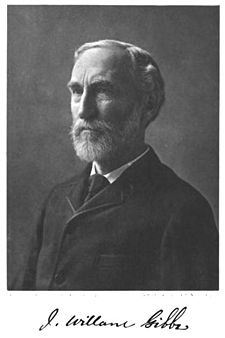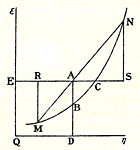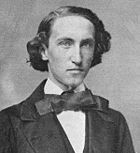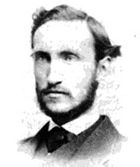Josiah Willard Gibbs
2008/9 Schools Wikipedia Selection. Related subjects: Chemists; Geographers and explorers
| J. Willard Gibbs | |
 (1839-1903)
|
|
| Born | February 11, 1839 New Haven, Connecticut, U.S. |
|---|---|
| Died | April 28, 1903 (aged 64) New Haven, Connecticut, U.S. |
| Residence | U.S. |
| Nationality | U.S. |
| Fields | Physicist |
| Institutions | Yale University |
| Alma mater | Yale University |
| Doctoral advisor | Gustav Kirchhoff Hermann von Helmholtz |
| Doctoral students | Edwin Bidwell Wilson Irving Fisher |
| Known for | Gibbs free energy Gibbs entropy Vector analysis Gibbs-Helmholtz equation Gibbs algorithm Gibbs distribution Gibbs state Gibbs phenomenon |
| Notable awards | Rumford Medal (1880) Copley Medal (1901) |
Josiah Willard Gibbs ( February 11, 1839 – April 28, 1903) was a preeminent American engineer, theoretical physicist, and chemist noted for his famed 1876 publication of On the Equilibrium of Heterogeneous Substances, a graphical analysis of multi-phase chemical systems, which laid the basis for a large part of modern-day science. As one of the greatest American scientists, he devised much of the theoretical foundation for chemical thermodynamics as well as physical chemistry. As a mathematician, he was an inventor of vector analysis. He spent his entire career at Yale, which awarded him the first American Ph.D. in engineering in 1863. In 1880, for his work in heat, Gibbs was awarded the Rumford Medal by the American Academy of Arts and Sciences.
In 1901, Gibbs was awarded the Copley medal of the Royal Society of London for being “the first to apply the second law of thermodynamics to the exhaustive discussion of the relation between chemical, electrical, and thermal energy and capacity for external work.” This summarizes Gibbs's most fruitful contribution to science. On February 28, 2003, Yale held a 100th anniversary symposium in his honour. According to the American Mathematical Society, which established the Josiah Willard Gibbs Lectureship in 1923 to increase public awareness of the aspects of mathematics and its applications, Gibbs is one of the greatest scientists America has ever produced. Nobelist Paul Samuelson describes Gibbs as " Yale's great physicist". In 1950, Gibbs was elected to the Hall of Fame for Great Americans.
Howard Scott leader of the Technical Alliance and later Technocracy Incorporated cited Gibbs as the intellectual scientific forefather of the concepts of Technocracy.
Biography
Early years
Gibbs was the seventh in a long line of American academics stretching back to the 17th century. His father, a professor of sacred literature at the Yale Divinity School, is now most remembered for his involvement in the Amistad trial. Although the father was also named Josiah Willard, the son is never referred to as "Jr." Five other members of Gibbs's extended family were named Josiah Willard Gibbs. His mother was the daughter of a Yale graduate in literature.
After attending the Hopkins School, Gibbs matriculated at Yale College at the age of 15. He graduated in 1858 near the top of his class, and was awarded prizes in mathematics and Latin.
Middle years
In 1863, Gibbs was awarded the first Ph.D. degree in engineering in the USA from the Sheffield Scientific School at Yale. He then tutored at Yale, two years in Latin and one year in what was then called natural philosophy, now comparable to the natural sciences, particularly physics. In 1866 he went to Europe to study, spending a year each at Paris, Berlin, and Heidelberg, where he was influenced by Kirchhoff and Helmholtz. At the time, German academics were the leading authorities in chemistry, thermodynamics, and theoretical natural science in general. These three years account for nearly all of his life spent outside New Haven.
In 1869, he returned to Yale and was appointed Professor of Mathematical Physics in 1871, the first such professorship in the United States and a position he held for the rest of his life. The appointment was unpaid at first, a situation common in Germany and otherwise not unusual at the time, because Gibbs had yet to publish anything. Between 1876 and 1878 Gibbs wrote a series of papers collectively titled On the Equilibrium of Heterogeneous Substances, now deemed one of the greatest scientific achievements of the 19th century and one of the foundations of physical chemistry. In these papers Gibbs applied thermodynamics to interpret physicochemical phenomena, successfully explaining and interrelating what had previously been a mass of isolated facts.
"It is universally recognised that its publication was an event of the first importance in the history of chemistry. ... Nevertheless it was a number of years before its value was generally known, this delay was due largely to the fact that its mathematical form and rigorous deductive processes make it difficult reading for anyone, and especially so for students of experimental chemistry whom it most concerns... " (J J O'Connor and E F Robertson, J. Willard Gibbs)
Some important topics covered in his other papers on heterogeneous equilibria include:
- The concepts of chemical potential and free energy (available energy);
- A Gibbsian ensemble ideal, a foundation of statistical mechanics;
- The Gibbs phase rule.

Gibbs also wrote on theoretical thermodynamics. In 1873, he published a paper on the geometric representation of thermodynamic quantities. This paper inspired Maxwell to make (with his own hands) a plaster cast illustrating Gibbs's construct which he then sent to Gibbs. Yale proudly owns it to this day.
Later years
In 1880, the new Johns Hopkins University in Baltimore, Maryland offered Gibbs a position paying $3000. Yale responded by raising his salary to $2000, and he did not leave New Haven. From 1880 to 1884, Gibbs combined the ideas of two mathematicians, the quaternions of William Rowan Hamilton and the exterior algebra of Hermann Grassmann to obtain vector analysis (independently formulated by the British mathematical physicist and engineer Oliver Heaviside). Gibbs designed vector analysis to clarify and advance mathematical physics.
From 1882 to 1889, Gibbs refined his vector analysis, wrote on optics, and developed a new electrical theory of light. He deliberately avoided theorizing about the structure of matter (a wise decision, given the revolutionary developments in subatomic particles and quantum mechanics that began around the time of his death), developing a theory of greater generality than any other theory of matter extant in his day.
After 1889, he worked on statistical mechanics, laying a foundation and "providing a mathematical framework for quantum theory and for Maxwell's theories" He wrote classic textbooks on statistical mechanics, which Yale published in 1902. Gibbs also contributed to crystallography and applied his vector methods to the determination of planetary and comet orbits.
Information about the names and careers of Gibbs's students is not readily available, yet one of his protegés was Edwin Bidwell Wilson, who in turn passed his Gibbsian knowledge onto Paul Samuelson. He is known to have strongly influenced the education of the economist Irving Fisher, who completed a Yale Ph.D. in 1896.
Gibbs never married, living all his life in his childhood home with a sister and his brother-in-law, the Yale librarian. His focus on science was such that he was generally unavailable personally. His protégé E.B. Wilson explains: "Except in the classroom I saw very little of Gibbs. He had a way, toward the end of the afternoon, of taking a stroll about the streets between his study in the old Sloane Laboratory and his home -- a little exercise between work and dinner -- and one might occasionally come across him at that time." Gibbs died in New Haven and is buried in Grove Street Cemetery.
Scientific recognition
Recognition was slow in coming, in part because Gibbs published mainly in the Transactions of the Connecticut Academy of Sciences, a journal edited by his librarian brother-in-law, little read in the USA and even less so in Europe. At first, only a few European theoretical physicists and chemists, such as the Scot James Clerk Maxwell, paid any attention to his work. Only when Gibbs's papers were translated into German (then the leading language for chemistry) by Wilhelm Ostwald in 1892, and into French by Henri Louis le Chatelier in 1899, did his ideas receive wide currency in Europe. His theory of the phase rule was experimentally validated by the works of H. W. Bakhuis Roozeboom, who showed how to apply it in a variety of situations, thereby assuring it of widespread use.
Gibbs was even less appreciated in his native America, yet in 1910 the Willard Gibbs Medal, founded by William A. Converse was established in his honour by the American Chemical Society, Chicago section.
During his lifetime, American secondary schools and colleges emphasized classics rather than science, and students took little interest in his Yale lectures. (That scientific teaching and research are a fundamental part of the modern university emerged in Germany during the 19th century and only gradually spread from there to the USA.) Gibbs's position at Yale and in American science generally has been described as follows:
"In his later years he was a tall, dignified gentleman, with a healthy stride and ruddy complexion, performing his share of household chores, approachable and kind (if unintelligible) to students. Gibbs was highly esteemed by his friends, but American science was too preoccupied with practical questions to make much use of his profound theoretical work during his lifetime. He lived out his quiet life at Yale, deeply admired by a few able students but making no immediate impress on American science commensurate with his genius." (Crowther 1969: nnn)
Not to say that Gibbs was unknown in his day. The mathematician Gian-Carlo Rota, while casually browsing the mathematical stacks of Sterling Library, stumbled upon a handwritten mailing list attached to Gibbs' course notes. It listed over two hundred of the most notable scientists of Gibb’s time, including Poincaré, Hilbert, Boltzmann, and Mach. One must infer that Gibbs' work was somewhat better known among the scientific elite of his day than public material suggests.
In 1945, Yale University created the J. Willard Gibbs Professorship in Theoretical Chemistry, held until 1973 by Lars Onsager, who won the 1968 Nobel Prize in chemistry. This appointment was a very fitting one, as Onsager, like Gibbs, was primarily involved in the application of new mathematical ideas to problems in physical chemistry, especially statistical mechanics. There is also a J. Willard Gibbs Professorship of Thermomechanics presently held by Bernard D. Coleman at Rutgers University.
J. W. Gibbs Laboratory at Yale and The J. Willard Gibbs Assistant Professorship in Mathematics at Yale were also named in his honour.
On May 4, 2005 the United States Postal Service issued the American Scientists commemorative postage stamp series, depicting Gibbs, John von Neumann, Barbara McClintock and Richard Feynman.
Nobelists derived from the works of Gibbs
In 1901, Gibbs was awarded the Copley Medal of the Royal Society of the United Kingdom, illustrating worldwide recognition of his work among contemporary theoreticians. This medal, awarded to only one scientist each year, was the highest possible honour granted by the international scientific community of his day.
Gibbs contributions, however, were not fully recognized until well after the 1923 publication of Gilbert N. Lewis and Merle Randall’s 1923 Thermodynamics and the Free Energy of Chemical Substances, which introduced the methods of Gibbs to chemists world-wide, and upon which the science of chemical engineering is largely founded. The following individuals won a Nobel Prize through the works of Gibbs:
- Dutch scientist Johann van der Waals won the 1910 Nobel prize in physics, which, as he states in his Nobel Lecture, is due in part to the works of Gibbs and his equations of state.
- The work of German physicist Max Planck, winner of 1918 Nobel prize in physics, in quantum mechanics, particularly his 1900 quantum theory paper, is largely based on thermodynamics of Rudolf Clausius, Gibbs, and Ludwig Boltzmann. Planck stated this about Gibbs: "…whose name not only in America but in the whole world will ever be reckoned among the most renowned theoretical physicists of all times…".
- At the turn of the 20th century, Gilbert Lewis worked in coordination with Merle Randall on the use of Gibbs chemical thermodynamic theories and published their results in the 1923 textbook Thermodynamics and the Free Energy of Chemical Substances, one of the two founding books in chemical thermodynamics. In the 1910s, William Giauque entered the College of Chemistry at Berkeley, where he received a bachelor of science degree in chemistry, with honours, in 1920. Although he entered university with an interest in becoming a chemical engineer, he soon developed an interest in research under the influence of Professor Gilbert Lewis. Due to his outstanding performance as a student, he became an Instructor of Chemistry at Berkeley in 1922 and after passing through the various grades of professorship, he became full Professor of Chemistry in 1934. In 1949, he won the Nobel Prize in Chemistry for his studies in the properties of matter at temperatures close to absolute zero in relation to the third law of thermodynamics.
- In 1947, American economist Paul Samuelson published Foundations of Economic Analysis, based on his Harvard University doctoral dissertation. Samuelson says that his work was influenced by the classical thermodynamic methods of Gibbs. Samuelson was sole recipient of the Nobel Prize in Economics in 1970, the second year of the Prize.
Tributes
left
—The greatest thermodynamicist of them all, John Fenn
…who founded a new department of chemical science which is becoming comparable in importance with that created by Lavoisier.
— Henri Louis Le Chatelier, formulator of Le Chatelier's principle (1885)
Willard Gibbs is, in my opinion, one of the most original and important creative minds in the field of science America has produced.
—Albert Einstein, German-Swiss physicist
To physical chemistry he gave form and content for a hundred years.
— Wilhelm Ostwald, German chemist
They laugh best who laugh last. Wait till we’re dead twenty years. Look at the way they’re treating poor Willard Gibbs, who during his lifetime can hardly have been considered any great shakes at New Haven.
— William James, American psychologist and philosopher
Quotations
- "Mathematics is a language." (reportedly spoken by Gibbs at a Yale faculty meeting)
- "A mathematician may say anything he pleases, but a physicist must be at least partially sane."
- "It has been said that 'the human mind has never invented a labor-saving machine equal to algebra.' If this be true, it is but natural and proper that an age like our own, characterized by the multiplication of labor-saving machinery, should be distinguished by the unexampled development of this most refined and most beautiful of machines." (1887, quoted in Meinke and Tucker 1992: 190)

